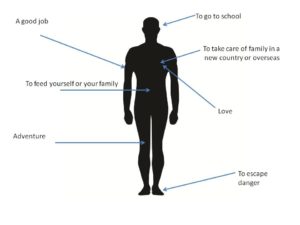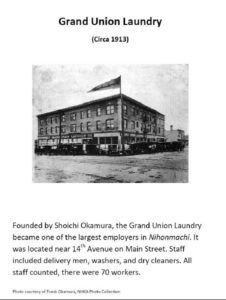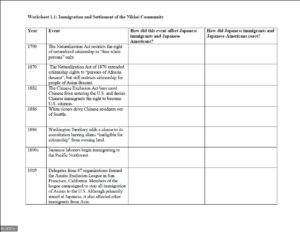The Thought: Students will become familiar with the ‘Push-Pull’ factors of immigrant experiences including discrimination, opportunity, family and community. Each of these factors has determined policy, perception and acceptance throughout American history.
Description: Japanese immigrants formed vibrant and thriving communities despite discriminatory attitudes and laws. Learning how their experiences differed from other immigrants allows students a deeper understanding of immigration past and present.
Student Objectives:
1. Identify various reasons Japanese immigrants settled in the United States.
2. Analyze ways Japanese immigrants and Japanese-Americans formed and maintained communities.
3. Explain how anti-Asian attitudes and legislation, particularly in Washington State, helped shape Japanese immigrant experiences prior to World War II.
Timeframe: This lesson is designed for two 45-minute class periods. An optional extension activity can be assigned as homework.
Materials: Human silhouette picture, Portrait Cards, Worksheet 1.1, Interview Sample Questions (for extension activity)
Readings: Divided Destiny: A History of Japanese Americans in Seattle (pg. 16-23), Meet Me at Higo: An Enduring Story of a Japanese-American Family (pg. 9-13)
Vocabulary:
alien
citizenship
discrimination
ethnicity
immigrant
Issei
Kibei
naturalization
Nihonmachi
Nikkei
Nisei
picture bride
Additional Resources: Divided Destiny: A History of Japanese Americans in Seattle by David
A. Takami, Meet Me at Higo: An Enduring Story of a Japanese-American Family by Ken Mochizuki, Asian Pacific American Timeline, A Community Grows Despite Racism (video)
Teacher Preparation: Read part 1 of Divided Destiny: A History of Japanese Americans in Seattle (through page 38) to learn more about Japanese immigration to the U.S., and JapanLesson 1 Worksheetese-American communities pre-1941. Review the timeline of Japanese-American history up to 1941 [Worksheet 1.1]. If desired, read through the Asian Pacific American timeline for more information and context.
Activity 1: Creating Community

1. Ask students what they know about immigration to the United States. Explain that immigration is the act of moving to a country you are not originally from, to permanently live there. Draw a silhouette of a person on the board (or use the provided silhouette). Ask students to brainstorm reasons why this person might move to a different country, and have them write or draw their answers next to the silhouette. For example, a student could write “to go to school” next  to the figure’s head, or draw a picture of a school. Other examples include making more money, escaping persecution, or reuniting with family members. Keep this visual displayed throughout the lesson for students to refer to.
to the figure’s head, or draw a picture of a school. Other examples include making more money, escaping persecution, or reuniting with family members. Keep this visual displayed throughout the lesson for students to refer to.
2. Divide students into five groups and pass out portrait cards 1-5, one to each group. [These cards focus on individual and family experiences.] Ask each group to read the card, look at the picture, and discuss why the person or family might have immigrated to Washington State. Have groups briefly share their answers with the class. If time allows, have groups exchange cards with another group and answer the same question for the new card. Compare the groups’ answers with each other, and emphasize that both answers may be right; families often had multiple reasons for immigrating.
3. Pass out a portrait cards 6-10, one to each group. [These cards focus on community institutions.] Ask students to study both cards, answer the following questions, and share their answers with the class.
![]()

a) What kinds of work and activities did Japanese immigrants and their families participate in?
b) How did Japanese immigrants adapt to life in a new country?
c) How were the experiences of Japanese immigrants similar and different to other immigrants of the time?
d) How are these experiences similar and different to immigrants coming to the U.S. today?
4. Divide students into pairs and ask them identify what elements of communities were important to Japanese immigrants. Examples include churches, schools, family-run businesses, community organizations, festivals, and holidays. How are these elements related to immigrants’ reasons for coming to the U.S.? Which of these institutions and events are important to you? Why?
5. Assign students to read pages 16-23 of Divided Destiny: A History of Japanese Americans in Seattle to learn more about the types of jobs Japanese immigrants performed, and pages 9-13 of Meet Me at Higo: An Enduring Story of a Japanese-American Family to learn about community life among Japanese immigrants.
Activity 2: Attitudes and Legislation
1. Ask students why they think Japanese immigrants chose to live in Japantown (Nihonmachi). Explain because of housing laws and discrimination, in many cities Japanese immigrants were only allowed to live in certain areas. Ask students to think of other examples of discriminatory laws, and how people affected by the laws reacted.
 2. Explain that there is a long history of anti-Asian attitudes and laws in U.S. Pass out Worksheet 1.1, which lists important laws and events affecting Japanese immigrants to the U.S. up to 1941. Have students read about each event and fill in the chart, based on their preexisting knowledge of immigration and their own opinions. (There may be multiple answers.)
2. Explain that there is a long history of anti-Asian attitudes and laws in U.S. Pass out Worksheet 1.1, which lists important laws and events affecting Japanese immigrants to the U.S. up to 1941. Have students read about each event and fill in the chart, based on their preexisting knowledge of immigration and their own opinions. (There may be multiple answers.)
3. After filling in the chart, have students share their answers with the class. Discuss the following questions in small groups or as a class.
a) What did each law or event indicate about attitudes toward Japanese immigration and settlement by the European-American majority?
b) Why do you think European-Americans wanted to exclude Japanese immigrants?
c) How were anti-Japanese laws consistent or inconsistent with previous laws toward other Asian and Pacific groups?
4. Ask students to place themselves in the shoes of a Japanese immigrant living in Seattle’s Japantown, and write a letter to a friend or relative living in Japan. In their letter, they should identify their reason(s) for coming to the U.S. They should also describe where they live, their daily life, their job or school, advantages of living in the U.S., difficulties they face, and how they create and maintain a community. Encourage students to use their imagination while also including evidence from the lesson.
5. Ask students what they think life was like for Japanese-American young adults prior to World War II. This will be the subject of the next lesson.
Extension Activity: Interview

Have students interview a relative, friend, or community member who has immigrated to the United States (or has a relative who immigrated). A list of suggested questions is included. Students may choose to:
Write a short essay reflecting on their experiences, and compare and contrast it to the experiences of Japanese immigrants.
Show the class a short video clip of the interview.
Take still photos of the interviewee and write simple reflections that describe what is being said at those moments.

